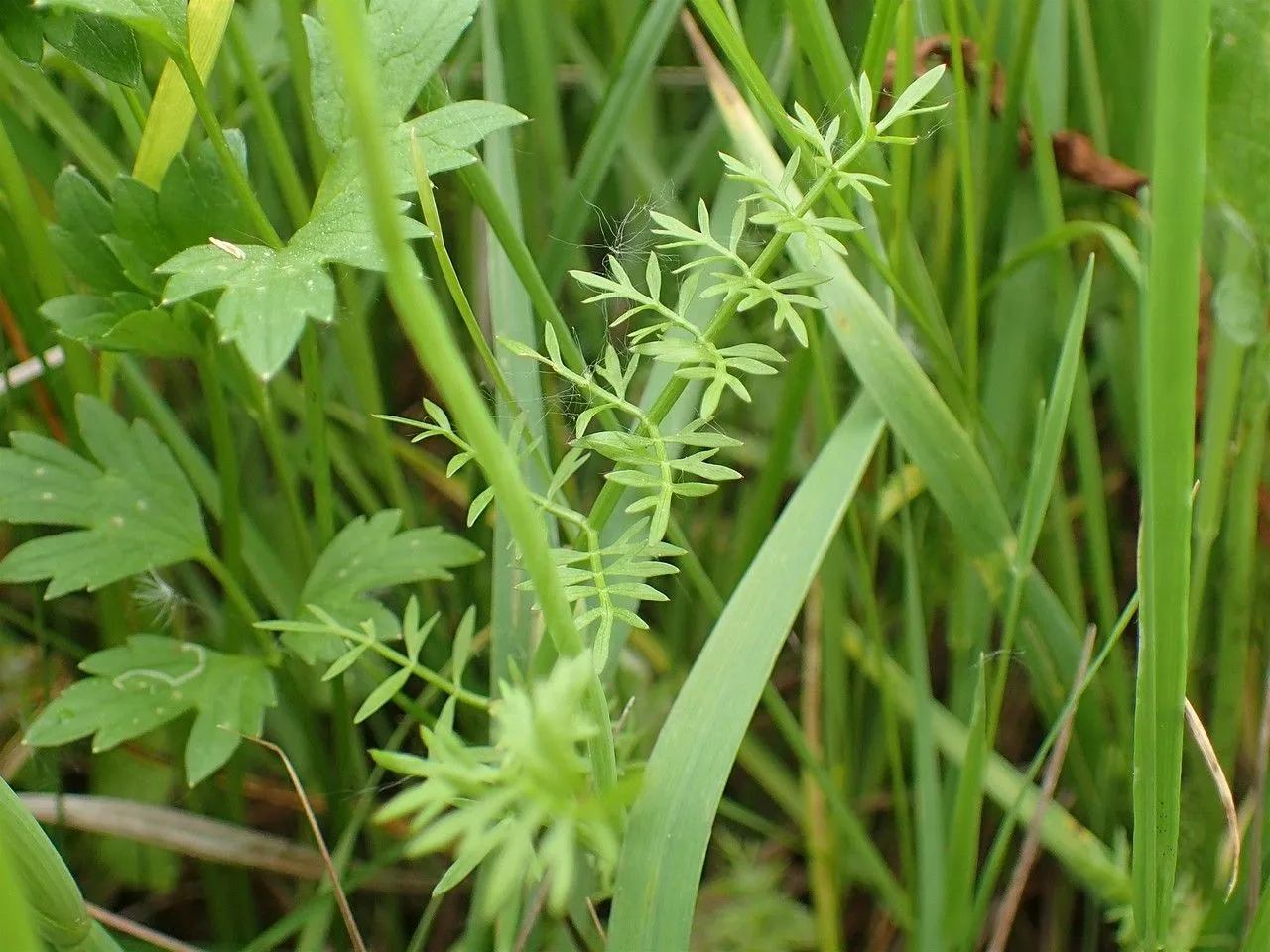
Author: L.
Bibliography: Sp. Pl.: 254 (1753)
Year: 1753
Status: accepted
Rank: species
Genus: Oenanthe
Vegetable: False
Observations: Europe to Medit. and NW. Iran
The Tubular water-dropwort, also known by its scientific name Oenanthe fistulosa, is a fascinating and resilient plant that plays a vital role in the ecosystems where it thrives. Originally described in the seminal work “Species Plantarum” in 1753 by the renowned botanist Carl Linnaeus, this species is a member of the Apiaceae family, which includes a plethora of aromatic plants often used in culinary, medicinal, and decorative applications.
Oenanthe fistulosa is predominantly found across Europe, extending its reach to the Mediterranean regions and the northwestern areas of Iran. Its natural habitat typically includes wetlands, marshes, and other areas with saturated soils, pointing to its adaptability to different moisture levels and climates.
Characterized by its hollow, tubular stems, the Tubular water-dropwort exhibits delicate, finely divided leaves and clusters of small, white flowers that bloom during the summer months. These floral displays not only add aesthetic value to natural water landscapes but also support a range of insects, including various pollinators.
Ecologically, the presence of Oenanthe fistulosa indicates healthy wetland environments. It contributes to the stabilization of soil and the provision of habitat for myriad aquatic and semi-aquatic species. The plant’s resilience and adaptability to diverse geographical locations make it a valuable indicator species for environmental monitoring and conservation efforts.
Given its widespread distribution and ecological significance, understanding and preserving the Tubular water-dropwort is essential for maintaining the biodiversity and health of wetland ecosystems across its native range.
Deu: röhrige rebendolde, röhriger wasserfenchel
Eng: tubular water-dropwort
Dan: vand-klaseskærm
Fra: oenanthe fistuleuse
Nld: pijptorkruid
Swe: pipstäkra
Nno: pipekjørvel
Nob: pipekjørvel
Cym: cegid pibellaidd, cegiden bibellaidd, dibynlor chwibog, dibynlor pibellaidd
Spa: ceguta de agua
En: Tubular water-dropwort, Water Lovage
Ca: Felandri fistulós
Da: Vand-klaseskærm
Nl: Pijptorkruid
Fr: Oenanthe fistuleuse
De: Röhriger Wasserfenchel, Röhrige Rebendolde, Röhrige-Pferdesaat
He: יינית נבובה
It: Finocchio-acquatico tubuloso
Nb: Pipekjørvel
Nn: Pipekjørvel
Es: Ceguta de Agua
Sv: Pipstäkra
Cy: Cegid Pibellaidd, Cegiden Bibellaidd, Dibynlor Chwibog, Dibynlor Pibellaidd
© copyright of the Board of Trustees of the Royal Botanic Gardens, Kew.
© copyright of the Board of Trustees of the Royal Botanic Gardens, Kew.
© copyright of the Board of Trustees of the Royal Botanic Gardens, Kew.
Taken Jun 9, 2018 by Tela Botanica − Liliane ROUBAUDI (cc-by-sa)
Taken Jun 9, 2018 by Tela Botanica − Liliane ROUBAUDI (cc-by-sa)
Taken Jun 9, 2018 by Tela Botanica − Liliane ROUBAUDI (cc-by-sa)
Taken Jun 9, 2018 by Tela Botanica − Liliane ROUBAUDI (cc-by-sa)
Taken Jul 10, 2022 by Peter Dukes (cc-by-sa)
Taken Aug 15, 2005 by Photoflora – Jean-Luc TASSET (©)
Taken May 18, 2017 by Yoan MARTIN (cc-by-sa)
Taken May 18, 2017 by Yoan MARTIN (cc-by-sa)
Taken Jun 7, 2013 by Tela Botanica − Liliane Roubaudi (cc-by-sa)
Taken Jun 7, 2013 by Tela Botanica − Liliane Roubaudi (cc-by-sa)
Taken May 27, 2012 by Tela Botanica − Hugues TINGUY (cc-by-sa)
Taken Aug 15, 2006 by Photoflora – Benoit BOCK (©)
Taken May 25, 2019 by Llandrich anna (cc-by-sa)
Taken May 18, 2017 by Yoan MARTIN (cc-by-sa)
Taken Nov 17, 2018 by Guénola Dujardin (cc-by-sa)
Taken Aug 15, 2006 by Photoflora – Benoit BOCK (©)
Taken May 25, 2019 by Llandrich anna (cc-by-sa)
Taken May 18, 2017 by Yoan MARTIN (cc-by-sa)
Taken Jun 7, 2013 by Tela Botanica − Liliane Roubaudi (cc-by-sa)
Taken Jun 7, 2013 by Tela Botanica − Liliane Roubaudi (cc-by-sa)
Taken Jun 9, 2018 by Tela Botanica − Liliane ROUBAUDI (cc-by-sa)
Taken Jun 9, 2018 by Tela Botanica − Liliane ROUBAUDI (cc-by-sa)
Taken May 25, 2019 by Llandrich anna (cc-by-sa)
Taken Jun 9, 2018 by Tela Botanica − Liliane ROUBAUDI (cc-by-sa)
Taken Jun 9, 2018 by Tela Botanica − Liliane ROUBAUDI (cc-by-sa)
Taken Aug 15, 2006 by Photoflora – Benoit BOCK (©)
Taken Aug 15, 2005 by Photoflora – Jean-Luc TASSET (©)
Taken Jan 1, 1970 by Photoflora – L’Abbé COSTE (©)
Taken Aug 15, 2011 by Photoflora – Benoit BOCK (©)
Ph maximum: 6.5
Ph minimum: 5.5
Light: 8
Atmospheric humidity: 9
Soil nutriments: 5
Family: Myrtaceae Author: (F.Muell.) K.D.Hill & L.A.S.Johnson Bibliography: Telopea 6: 402 (1995) Year: 1995 Status:…
Family: Rubiaceae Author: Pierre ex A.Froehner Bibliography: Notizbl. Bot. Gart. Berlin-Dahlem 1: 237 (1897) Year:…
Family: Sapindaceae Author: Koidz. Bibliography: J. Coll. Sci. Imp. Univ. Tokyo 32(1): 38 (1911) Year:…
Family: Asteraceae Author: A.Gray Bibliography: Pacif. Railr. Rep.: 107 (1857) Year: 1857 Status: accepted Rank:…
Family: Fabaceae Author: Medik. Bibliography: Vorles. Churpfälz. Phys.-Ökon. Ges. 2: 398 (1787) Year: 1787 Status:…
Family: Aspleniaceae Author: (Cav.) Alston Bibliography: Bull. Misc. Inform. Kew 1932: 309 (1932) Year: 1932…